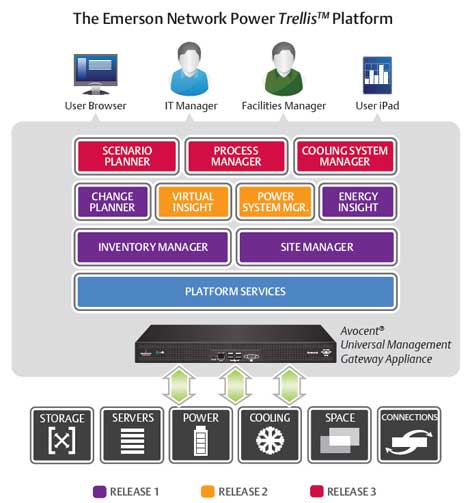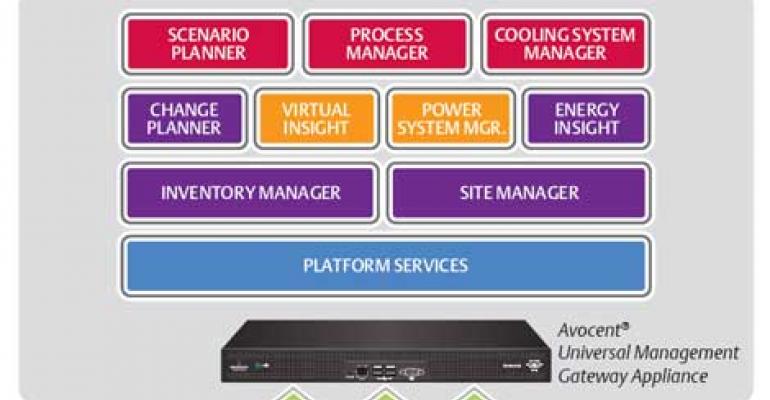
Emerson Network Power has updated its Trellis DCIM platform, adding greater depth to its power management and mobility capabilities.
“With every release that we do, we’re enhancing the base level platform," said Steve Hassell, President, Data Center Solutions at Emerson Network Power. "Like any product, we take the feedback from our users. It’s about knowing what you have, knowing what your doing with it, then answering progressively complex questions.”
The two new modules are:
- Trellis Power System Manager, which gives deeper visualization of the power system. Its utilization, and dependencies.
- The Trellis Mobile Suite, an app that allows users to manage data center assets in real-time, anywhere and anytime, by transforming a mobile device into a portal to the Trellis platform.
“The two modules provide more in-depth capabilities,” said Hassell. “From a power standpoint, Energy Insight in Trellis was good for high level PUE (Power Usage Effectiveness) stuff. Now you can look at the data center the way that an electrical engineer looks at the data center. The power chain management piece is a key part of what we added in 2.1.”
The Power System Manager module provides a complete visualization of the power system, including utilization and dependencies. Users can view the complete power chain from the grid to the rack via a one-line diagram. It lets users document the complete power system, view capacity utilization in real-time and forecast energy consumption. This improves business continuity and reduces operational costs. It also helps users plan for capacity more accurately.
The ability to gain insight into power usage is big. “We had one customer that thought they were out of power, getting ready to do a fairly large expansion,” said Hassell. “What they really had was stranded capacity, they were really only using 15 percent."
The module lets the user know exactly which racks or devices will be affected by any power system failure or by scheduled maintenance, so they can identify and address potential issues before they cause an outage. Additionally, the module lets users better plan for power maintenance and perform risk assessments.
Mobile Management Module
The Mobile Suite module adds capabilities that greatly enhance management. “One of the toughest things with the inventory management model is getting the inventory into the application and use it in a way that’s pretty productive,” said Hassell. "With this module, you can use something like an iPad. You’re able to read barcodes, we did some things with facial recognition and it will identify the server."
While servers look pretty similar to the naked eye, the new module means that with an iPad, you can go up to a server take a snapshot and it identifies it for you. “Servers have very subtle nuances," said Hassell. "One of the things that we store is that visual image,” said Hassell.
Before this, it was difficult to get the inventory in the first place. A lot of data center floors didn’t have wireless access, so the device used to take inventory was physically connected. In some cases, staff wrote on paper. "With the iPad, it can do the two way communication dynamically, if not it’ll store it locally.”
“Discussions with our closest customers on our advisory boards indicated they needed additional flexibility and holistic insight for power management, and that they would benefit from the ability to take Trellis anywhere, 24/7,” said Hassell.
Bridging the IT/Facilities Gap
The biggest promise of DCIM seems to be bridging the gap between IT and facilities, who often have their own way of doing things that leads to a disconnect in both operations and understanding. “We’re very good at building closed looped control systems that let physical devices act as one,” said Hassell. “We’re building a connection between IT and physical, and letting you make better decisions.
“This shows further commitment that it really does take a platform where different modules reinforce themselves,” said Hassell. “With Trellis, you don’t have to buy the whole thing; you can start out where you need to and expand. When you look across all our data center customers, we cover a pretty wide swath of the IT customers out there. We’re taking a lot of input and we’ll continue to release capabilities at a fast pace.”
Hassell compares DCIM to virtualization and VMWare. “With DCIM, you’re abstracting the infrastructure in the way server virtualization abstracted,” said Hassell. “Virtualization as a technology, (and) even VMware went through a period of time before the big adoption wave. I’m not sure we’re really at the inflection point. I’d say the community is always very bullish. It’s gone past the frothy promise. There’s a tremendous amount of interest a lot of proof of concept. A lot of customers are starting off in one place in their environment and moving up.”





